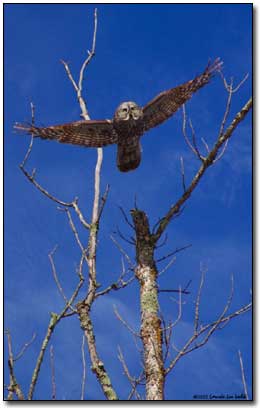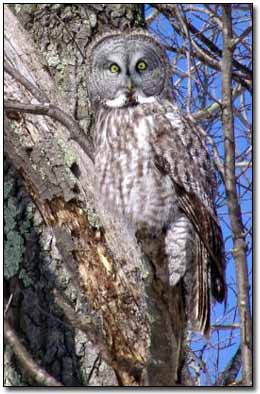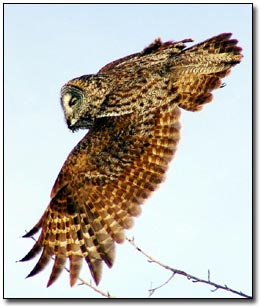|
The winter of 2005 brought a pleasant surprise to Minnesota photographers. In mid January, the
 Great Gray Owl, and the Northern Hawk Owl arrived in large numbers to the Solana State Forest of McGrath, MN, where I live, as well as other areas of Northern Minnesota.
Great Gray Owl, and the Northern Hawk Owl arrived in large numbers to the Solana State Forest of McGrath, MN, where I live, as well as other areas of Northern Minnesota.
The Minnesota DNR reports that the influx of owls started as early as October, caused by early ice storms and lack of sufficient prey to sustain their large population in their natural Northern Canadian habitat, this influx peaked in mid January.
I became so intrigued by their peaceful presence, I found myself entranced by observing their beauty and marveling at their "still hunting" techniques. I spent almost every day from mid January through March outside in the snow-banks observing and photographing this "once in a lifetime" event, which peaked my interest in researching this species.
The Great Gray Owl is also known as Sooty Owl, Great Gray Ghost, Cinerous Owl, Spectral Owl, Lapland Owl, Spruce Owl, Bearded Owl and Phantom of the North.
The Native Americans called the Great Gray Owl "Wa-Sha-Quon-Asin", translated "He Who Flies by Night".
Because of this species seemingly magical appearance in winter and disappearance as fast as he came, he earned the nickname "Phantom of the North".
Kingdom: Animalia
Phylum: Chordata
Class: Aves
Order: Strigiformes
Family: Strigidae
Genus: Strix (latin meaning 'screech owl')
Species: nebulosa (latin meaning 'misty' or 'foggy')
Description:
One of the world's largest, but not heaviest owls, the Great Gray Owl is dark brownish & grey overall interspersed with bars and flecks of light grey and white. When perched, they appear very bulky because of their dense, fluffy plumage which serves as insulation. They sport a relatively long tail, long wings extending past the body when folded, and a large roundish head. Its elegant proportions and striking facial disk which bears alternating dark & light concentric rings around piercing yellow eyes give the Great Gray Owl an appearance which is both beautiful and stunning, making it one of the worlds most instantly recognizable raptors. A noticeable white strip almost resembling a 'mustache' is under the facial disk, broken by a black 'bow-tie'. A pair of puffy grey eyebrows lie back to
back between the eyes and gently curve around the top of the beak.
When perched the feet remain hidden from view. When in motion it is noticed that from legs to talons they appear to be covered with buff colored velvety fur which is actually a densely feathered covering giving them an appearance of wearing 'furry mitts' or 'booties'.
Compared to other owls one of the most distinctive things about the Great Gray are the rather small eyes for the owls size. It's distinct eyes are thought to possibly be an adaptation towards daylight hunting.
Length: 24-33", average 28" for females, 27" for males
Weight: 28-51oz average 49oz for females, 45oz for males.
Wingspan: up to 60", average 56" for female, 55" for males
Although the Great Gray Owl looks large enough to be the Great Horned Owl's equal, the Great Horned Owl is approximately 125% larger in body weight than the Great Gray, whose large appearance is accounted for by its insulating feathers. Underneath these plenteous feathers, the Great Gray Owl is barely larger than its close relative the Tawny Owl.
Range & Distribution:
 Great Gray Owls are found in the boreal forest zone from Alaska across Canada, down the Northern Rocky
Mountains, and northern Minnesota.In far north America, they frequent stunted coniferous forests along the edge of the Arctic treeline, through spruce and tamarack muskeg forests further south. They are also found in northern Europe and northern Asia, with the North American Great Grays being about 4% larger
and heavier than their Eurasian cousins.
Great Gray Owls are found in the boreal forest zone from Alaska across Canada, down the Northern Rocky
Mountains, and northern Minnesota.In far north America, they frequent stunted coniferous forests along the edge of the Arctic treeline, through spruce and tamarack muskeg forests further south. They are also found in northern Europe and northern Asia, with the North American Great Grays being about 4% larger
and heavier than their Eurasian cousins.
Great Gray Owls prefer the lichen covered forest of the spruce, tamarack and pine but inhabit a range of forested habitats.
Adaptation to Cold Climate:
For much of its life, the Great Gray Owl is above the snow line, and the temperatures in which it lives are extremely low. It is, however, extremely well equipped with very effective feather insulation. When hot, a Great Gray Owl will pant and droop its wings to expose an unfeathered area (apterid) under the wing. The Great Gray Owl thermo-regulates by roosting in dense cover.
Hunting & Food:
Owls are birds of prey (raptors) that are especially adapted for hunting at night (nocturnal), however, the Great Gray Owl is diurnal, hunting both night and day. Most foraging is done in open areas such as swamps, bogs, along roads and forest clearings with scattered trees and shrubs that can be used as perches. The Great Gray is an owl which is adapted superbly for its preferred environment with low light conditions of dense forest cover, hunting is done almost entirely by sound, allowing this owl to locate prey that would otherwise be hidden safely under snow-cover from most other predators.
Equipped with superb hearing (good enough to pick up movements of prey species under a foot or more of snow) and superior eyesight (aided by the focusing effect of the deep facial discs) is sharp enough in daylight to spot a vole or lemming in the snow at more than 200 yds away, they rarely miss their prey.
The eyes face forward in a flat, broad-feathered, 'facial disk', not found in other birds. In this way, both eyes see the same object at the same time, providing the bird with 'binocular vision'. Binocular vision enables an owl to judge distances between objects and thus increases the bird's ability to maneuver in a crowded environment. Because the eyes are immovably 'fixed' in their sockets, an owl must
turn its head to focus in on and follow moving objects, which is aided by a long and flexible neck that allows the owl to turn its head about 270 degrees around.
Unlike other raptors, such as hawks and eagles, owls fly on soft and silent wings. Soft, comblike projections on flight feathers effectively muffle the sound of air passing over the wings. They can maneuver among trees and shrubs, hover silently and drop on their prey without warning.
Like other raptors, owls have strong feet with sharp, curved talons used for grasping and carrying prey; and they have strong, hooked beaks which easily tear flesh. Along with their excellent sight, owls also locate their prey with an acute sense of hearing. The openings to the ears are large, and hidden behind the facial disk. The right ear is positioned high on the head, while the left ear is low. Because of
their unique positioning, sound reaches one ear before the other, enabling the owl to detect exactly where the sound is coming from.
Great Gray Owls migrate to the southern portions of their breeding range to spend the winter. Others, like the great horned, are resident throughout the year, only marginally moving to more favorable hunting areas in winter.
 The Great Gray Owl hunts mainly during early morning and late afternoon, especially during winter, but
will also hunt during other daylight hours and at night. They are often seen perched on poles or fenceposts along roads. When hunting, a Great Gray Owl will use a perch to 'still hunt' perching, watching and listening until they find their prey, then they pursue it on wing, swooping down to snatch or diving talon and head first in the snow. They sometimes hunt through the forest flying a few feet above the ground. When the ground is covered with snow hiding their prey, a Great Gray Owl will hunt
by hearing alone and often plunges into the snow to capture small rodents moving underneath as far as 12 inches deep. Although a very large Owl, small rodents are their primary prey, over 90% of their diet consists of voles, being the most important food . Other mammals taken include rats, mice, shrews, squirrels, rabbits, chipmunks, moles, and weasels. Birds are rarely captured and snakes, frogs, toads, and insects are taken very infrequently.
The Great Gray Owl hunts mainly during early morning and late afternoon, especially during winter, but
will also hunt during other daylight hours and at night. They are often seen perched on poles or fenceposts along roads. When hunting, a Great Gray Owl will use a perch to 'still hunt' perching, watching and listening until they find their prey, then they pursue it on wing, swooping down to snatch or diving talon and head first in the snow. They sometimes hunt through the forest flying a few feet above the ground. When the ground is covered with snow hiding their prey, a Great Gray Owl will hunt
by hearing alone and often plunges into the snow to capture small rodents moving underneath as far as 12 inches deep. Although a very large Owl, small rodents are their primary prey, over 90% of their diet consists of voles, being the most important food . Other mammals taken include rats, mice, shrews, squirrels, rabbits, chipmunks, moles, and weasels. Birds are rarely captured and snakes, frogs, toads, and insects are taken very infrequently.
The Great Gray Owl does not often move more than short distances between perches and seldom glides. They fly close to the ground, except when flying to a nest.
Breeding & nesting:
They are unintimidated by human presence, enabling their range to extend peacefully to human habitation when hunting, but their nesting site is defended vigorously and effectively from humans and predators alike. Courtship involves feeding and mutual preening between mates and begins in midwinter.
The male typically approaches the female, holding food in its beak, which is passed with both birds closing their eyes.
The male seeks possible nest sites and attracts its mate with calls. Several sites are inspected before the female accepts a nesting site. The Great Gray Owl nests primarily in stick nests made by ravens, hawks, or crows, usually in the top of large-diameter snags. They also readily take to artificial
platforms or nests placed in suitable habitat. Unlike most other owls, their nests are usually tidied up and refurbished before use. Nest linings include conifer needles, animal hair, moss, and shredded bark on which 2 to 9 plain white eggs are laid over a period of several days. The female does all incubation while the male hunts and provides all food to the female and young. Unlike most birds whose incubation does not start until the last egg is laid, the Great Gray's incubation and embryo development begins with the first egg laid and lasts 28 to 29 days with eggs hatching over a period of several days. During this
time the hen maintains them at a temperature of around 90F degrees while the surrounding air temperature may drop as low as -10F degrees!
The older nestlings are larger thus have a greater chance of survival than younger, smaller ones. Young owls are cared for by both parents. Nestling owls are very demanding, having enormous appetites. They can eat their own weight in food in a single night. The female tears food into small pieces to feed the young. Fledglings occurs after about 10 weeks and young remain near the nest for several months, with the male hunting and the female caring for them.
Great Gray Owls lay single broods but will lay replacement clutches if the first clutch or brood is lost. Males and females aggressively defend nests and have been known to drive off predators as large as black bears. Among other threats, ravens and Great Horned Owls will prey on eggs and nestlings.
Mortality:
They are long-lived birds, with captive owls living to 40 years of age. Mortality in the wild is often due to starvation. Natural enemies that prey on juveniles are Great Horned Owls, marten, and wolverines. Fatalities caused by humans include shootings, tangling in fences, road kills, and electrocutions.
Migration:
What causes their migration? After a couple of years of breeding, there are a lot of owls in their natural range which causes the vole population to plummet, forcing their migration to places like
northern Minnesota looking for food. Another factor is harsh weather. Early northern ice storms this past fall forced the birds further south than their natural range. Being raptors that hunt for prey
under the snow, ice makes their hunting very difficult. There is usually an increased number of sightings from fall to February, and then a decrease in numbers as you get closer to March, which is when the owls start to breed. The great grey owls then return to familiar areas, often the same nest sites they've used before. Enjoy them while they are here, be kind to our guests. They are one of the most beautiful & intriguing sights you'll ever see in the forest!
By popular request, and in commemoration of this unusual event, I am offering Limited Edition signed/numbered and dated prints of the Great Gray Owl to the public.
|

